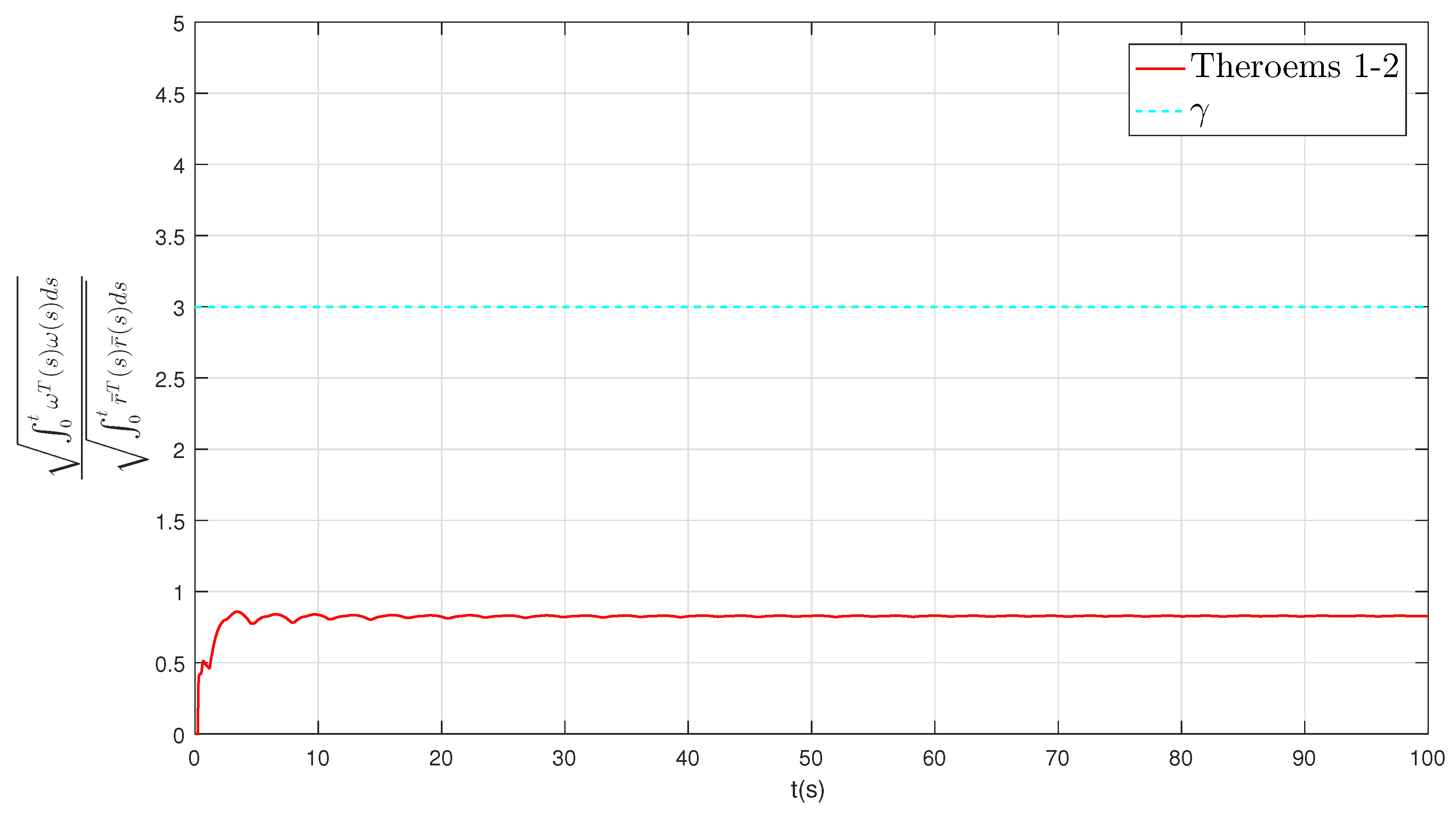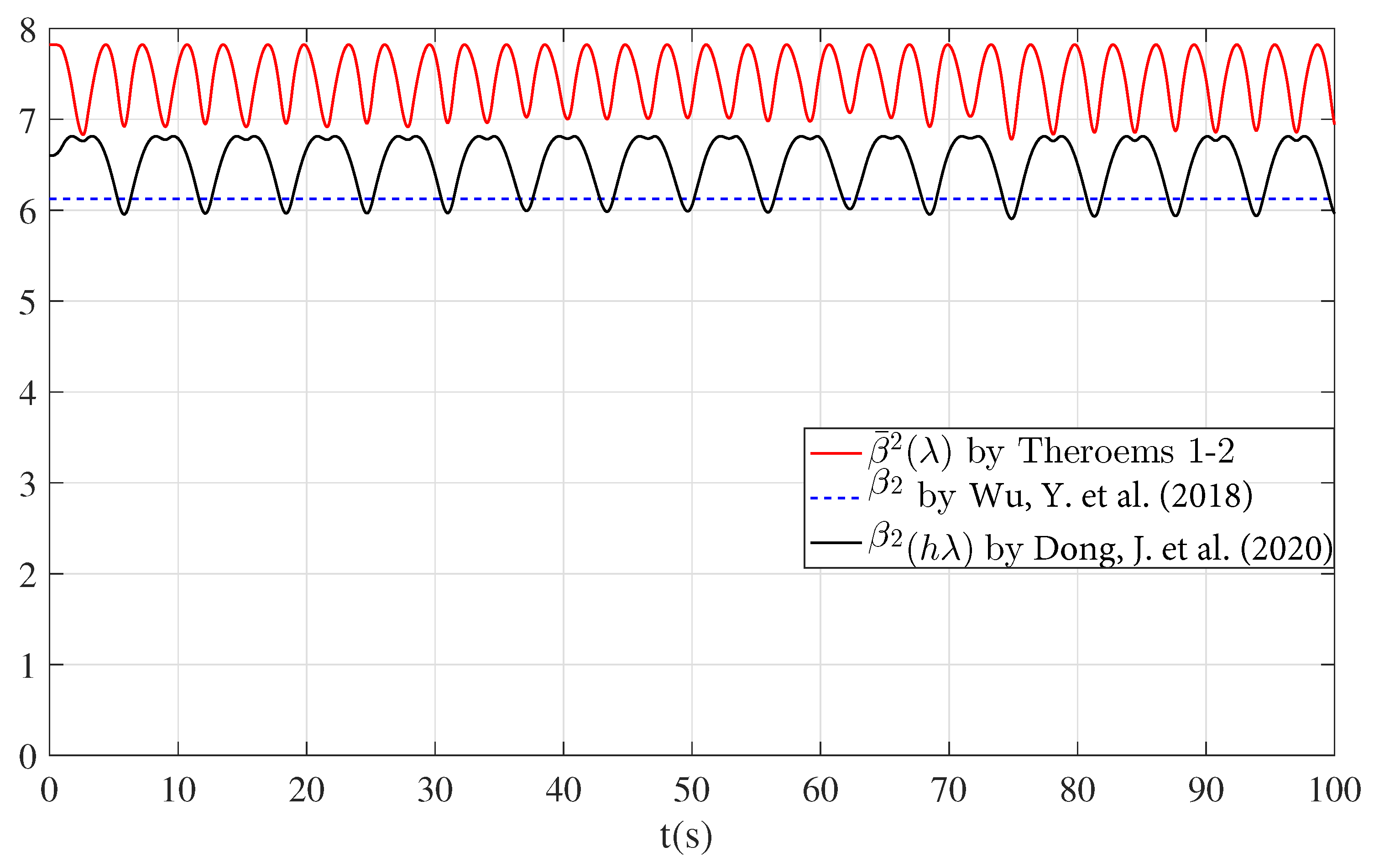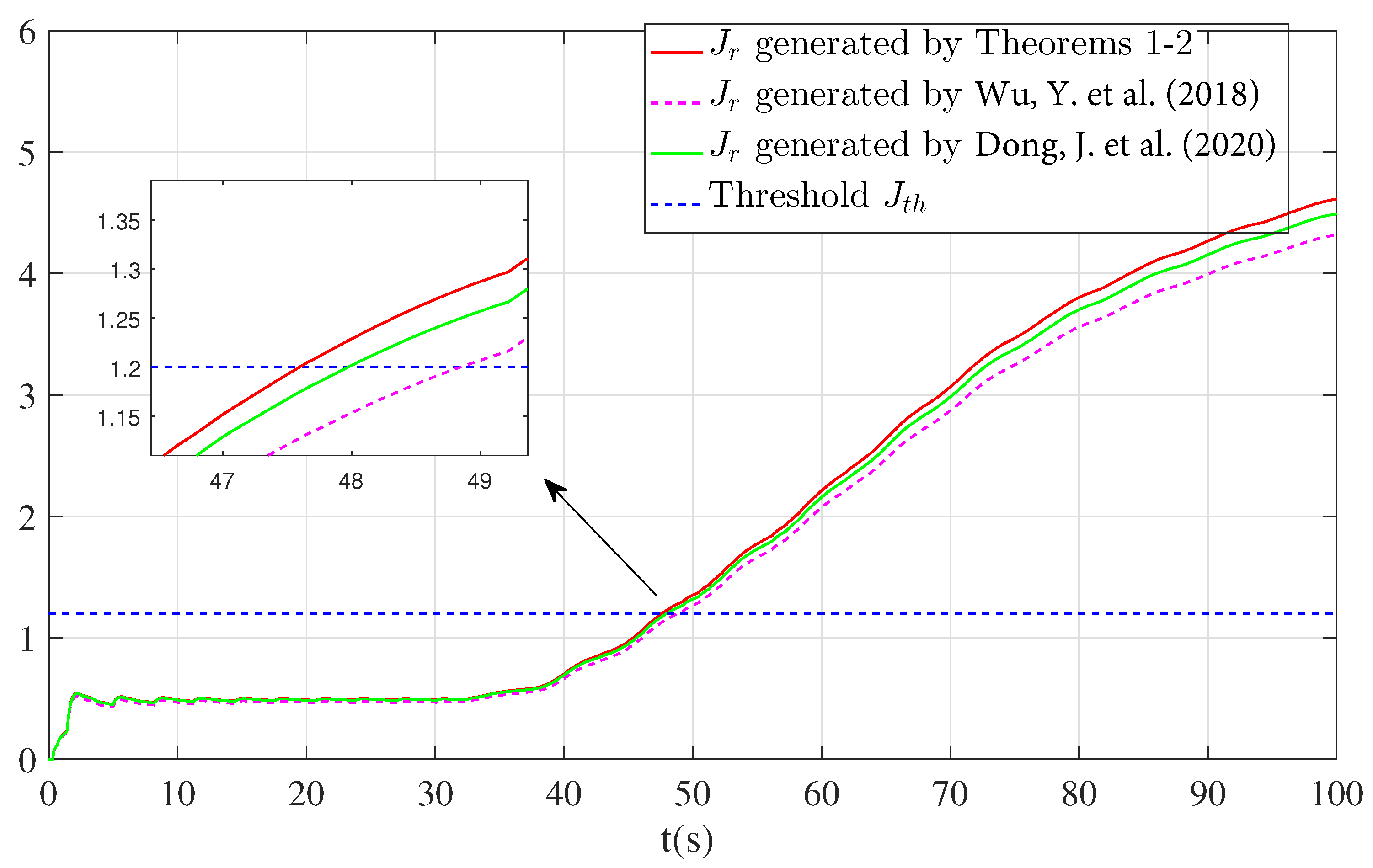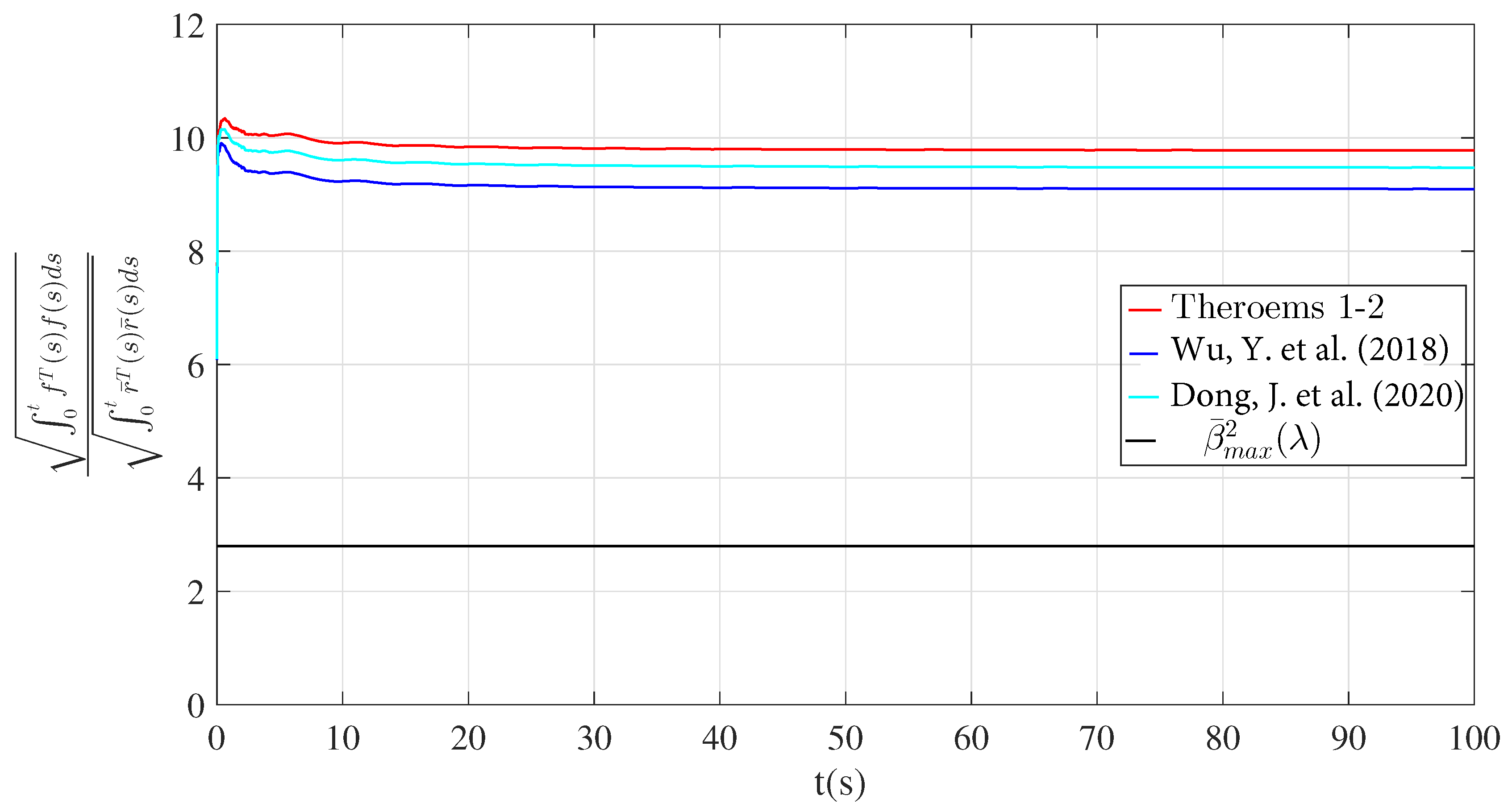Fuzzy Fault Detection Observer Design for Unmanned Marine Vehicles Based on Membership-Function-Dependent H∞/H_ Performance
Abstract
1. Introduction
- (1)
- Inspired by the literature [22], a new membership-function-dependent FD strategy is proposed for UMVs in this paper. In the method developed, the fuzzy submodels, in which the system always works, can have a larger performance index; then, the property that the state of the system is limited to a local area can be fully made use of such that the FD performance for UMVs can be improved.
- (2)
- Motivated by set theory description [17], the FD performance index is designed to depend on the membership functions, which can take a relatively large value when the state is limited to a local area. Consequently, the FD performance can be improved as long as the state of the system is limited to a local area. Then, the constraint that the fuzzy systems are required to work on a certain subsystem in [22] can be removed by the proposed method.
2. System Description
UMVs T-S Modeling
3. Fault Detection Observer Design
3.1. Quantization Description
3.2. FD Observer Scheme
3.3. Problem Formulation
4. FD Observer Analysis and Synthesis
4.1. Membership-Function-Dependent FD Observer Synthesis Conditions
4.2. FD Logic and Optimized Algorithm
5. Example
6. Conclusions
Author Contributions
Funding
Institutional Review Board Statement
Informed Consent Statement
Data Availability Statement
Conflicts of Interest
References
- Wang, Y.; Jiang, B.; Wu, Z.-G.; Xie, S.; Peng, Y. Adaptive sliding mode fault-tolerant fuzzy tracking control with application to unmanned marine vehicles. IEEE Trans. Syst. Man Cybern. Syst. 2020, 51, 6691–6700. [Google Scholar] [CrossRef]
- Shah, B.C.; Gupta, S.K. Long-distance path planning for unmanned surface vehicles in complex marine environment. IEEE J. Ocean. Eng. 2019, 45, 813–830. [Google Scholar] [CrossRef]
- Verfuss, U.K.; Aniceto, A.S.; Harris, D.V.; Gillespie, D.; Fielding, S.; Jiménez, G.; Johnston, P.; Sinclair, R.R.; Sivertsen, A.; Solbø, S.A. A review of unmanned vehicles for the detection and monitoring of marine fauna. Mar. Pollut. Bull 2019, 140, 17–29. [Google Scholar] [CrossRef] [PubMed]
- Wang, Y.-L.; Han, Q.-L. Network-based modelling and dynamic output feedback control for unmanned marine vehicles in network environments. Automatica 2018, 91, 43–53. [Google Scholar] [CrossRef]
- Yang, T.; Jiang, Z.; Sun, R.; Cheng, N.; Feng, H. Maritime search and rescue based on group mobile computing for unmanned aerial vehicles and unmanned surface vehicles. IEEE Trans. Ind. Inform. 2020, 16, 7700–7708. [Google Scholar] [CrossRef]
- Sands, T. Development of deterministic artificial intelligence for unmanned underwater vehicles (UUV). J. Mar. Sci. Eng. 2020, 8, 578. [Google Scholar] [CrossRef]
- Petillot, Y.R.; Antonelli, G.; Casalino, G.; Ferreira, F. Underwater robots: From remotely operated vehicles to intervention-autonomous underwater vehicles. IEEE Robot. Autom. Mag. 2019, 26, 94–101. [Google Scholar] [CrossRef]
- Liu, C.; Zhao, X.; Wang, X.; Ren, X. Adaptive fault identification and reconfigurable fault-tolerant control for unmanned surface vehicle with actuator magnitude and rate faults. Int. J. Robust Nonlinear Control 2023, 33, 5463–5483. [Google Scholar] [CrossRef]
- Corradini, M.L.; Monteriu, A.; Orlando, G. An actuator failure tolerant control scheme for an underwater remotely operated vehicle. IEEE Trans. Control. Syst. Technol. 2010, 19, 1036–1046. [Google Scholar] [CrossRef]
- Wai, R.-J.; Yang, Z.-W. Adaptive fuzzy neural network control design via a T-S fuzzy model for a robot manipulator including actuator dynamics. IEEE Trans. Syst. Man Cybern. Part B (Cybern.) 2008, 38, 1326–1346. [Google Scholar]
- Ma, X.; Wong, P.K.; Zhao, J.; Xie, Z. Cornering stability control for vehicles with active front steering system using TS fuzzy based sliding mode control strategy. Mech. Syst. Signal Process. 2019, 125, 347–364. [Google Scholar] [CrossRef]
- Shen, Q.; Jiang, B.; Shi, P. Adaptive fault diagnosis for T-S fuzzy systems with sensor faults and system performance analysis. IEEE Trans. Fuzzy Syst 2013, 22, 274–285. [Google Scholar] [CrossRef]
- Yang, H.; Zhang, K.-P.; Liu, H.-E. Online regulation of high speed train trajectory control based on TS fuzzy bilinear model. IEEE Trans. Intell. Transp. Syst. 2015, 17, 1496–1508. [Google Scholar] [CrossRef]
- Vafamand, N.; Asemani, M.H.; Khayatiyan, A.; Khooban, M.H.; Dragičević, T. TS fuzzy model-based controller design for a class of nonlinear systems including nonsmooth functions. IEEE Trans. Syst. Man Cybern. Syst. 2017, 50, 233–244. [Google Scholar] [CrossRef]
- Li, X.-J.; Yang, G.-H. Fault detection for T-S fuzzy systems with unknown membership functions. IEEE Trans. Fuzzy Syst. 2013, 22, 139–152. [Google Scholar] [CrossRef]
- Yan, J.-J.; Yang, G.-H.; Li, X.-J. Fault detection in finite frequency domain for TS fuzzy systems with partly unmeasurable premise variables. Fuzzy Sets Syst. 2021, 421, 158–177. [Google Scholar] [CrossRef]
- Dong, J.; Wu, Y.; Yang, G.-H. A new sensor fault isolation method for T-S fuzzy systems. IEEE Trans. Cybern. 2017, 47, 2437–2447. [Google Scholar] [CrossRef] [PubMed]
- Li, H.; Gao, Y.; Wu, L.; Lam, H.-K. Fault detection for TS fuzzy time-delay systems: Delta operator and input-output methods. IEEE Trans. Cybern. 2014, 45, 229–241. [Google Scholar] [CrossRef]
- Wu, Y.; Dong, J. Fault detection for T-S fuzzy systems with partly unmeasurable premise variables. Fuzzy Sets Syst. 2018, 338, 136–156. [Google Scholar] [CrossRef]
- Wu, Y.; Dong, J. Simultaneous local stabilisation and fault detection for continuous-time T-S fuzzy systems. IET Control. Theory Appl. 2019, 13, 1071–1083. [Google Scholar] [CrossRef]
- Wu, Y.; Dong, J. Fault detection for non-Gaussian stochastic distribution fuzzy systems by an event-triggered mechanism. IISA Trans. 2019, 91, 135–150. [Google Scholar] [CrossRef] [PubMed]
- Dong, J.; Hou, Q.; Ren, M. Control synthesis for discrete-time T–S fuzzy systems based on membership function-dependent H∞ performance. IEEE Trans. Fuzzy Syst. 2020, 28, 3360–3366. [Google Scholar] [CrossRef]
- Takagi, T.; Sugeno, M. Fuzzy identification of systems and its applications to modeling and control. IEEE Trans. Syst. Man Cybern. 1985, 116–132. [Google Scholar] [CrossRef]
- Dong, J.; Yang, G.-H. Reliable state feedback control of T-S fuzzy systems with sensor faults. IEEE Trans. Fuzzy Syst. 2014, 23, 421–433. [Google Scholar] [CrossRef]
- Fu, M.; Xie, L. The sector bound approach to quantized feedback control. IEEE Trans. Autom. Control. 2005, 50, 1698–1711. [Google Scholar]
- Li, Z.-M.; Chang, X.-H.; Xiong, J. Event-based fuzzy tracking control for nonlinear networked systems subject to dynamic quantization. IEEE Trans. Fuzzy Syst. 2022, 31, 941–954. [Google Scholar] [CrossRef]
- Thabet, A.; Frej, G.H.; Boutayeb, M. Observer-based feedback stabilization for lipschitz nonlinear systems with extension to H∞ performance analysis: Design and experimental results. IEEE Trans. Control. Syst. Technol. 2017, 26, 321–328. [Google Scholar] [CrossRef]
- Wang, Y.-L.; Han, Q.-L.; Fei, M.-R.; Peng, C. Network-based T-S fuzzy dynamic positioning controller design for unmanned marine vehicles. IEEE Trans. Cybern. 2018, 48, 2750–2763. [Google Scholar] [CrossRef]
- Hao, L.-Y.; Zhang, H.; Li, T.-S.; Lin, B.; Chen, C.P. Fault tolerant control for dynamic positioning of unmanned marine vehicles based on TS fuzzy model with unknown membership functions. IEEE Trans. Veh. Technol. 2021, 70, 146–157. [Google Scholar] [CrossRef]
- Wang, Y.; Hao, L.-Y.; Li, T.; Chen, C.P. Integral sliding mode-based fault-tolerant control for dynamic positioning of unmanned marine vehicles based on a TS fuzzy model. J. Mar. Sci. Eng. 2023, 11, 370. [Google Scholar] [CrossRef]



Disclaimer/Publisher’s Note: The statements, opinions and data contained in all publications are solely those of the individual author(s) and contributor(s) and not of MDPI and/or the editor(s). MDPI and/or the editor(s) disclaim responsibility for any injury to people or property resulting from any ideas, methods, instructions or products referred to in the content. |
© 2024 by the authors. Licensee MDPI, Basel, Switzerland. This article is an open access article distributed under the terms and conditions of the Creative Commons Attribution (CC BY) license (https://creativecommons.org/licenses/by/4.0/).
Share and Cite
Wu, Y.; Wang, Y.; Zhang, K.; Zhang, S.; Wu, Y. Fuzzy Fault Detection Observer Design for Unmanned Marine Vehicles Based on Membership-Function-Dependent H∞/H_ Performance. J. Mar. Sci. Eng. 2024, 12, 1288. https://doi.org/10.3390/jmse12081288
Wu Y, Wang Y, Zhang K, Zhang S, Wu Y. Fuzzy Fault Detection Observer Design for Unmanned Marine Vehicles Based on Membership-Function-Dependent H∞/H_ Performance. Journal of Marine Science and Engineering. 2024; 12(8):1288. https://doi.org/10.3390/jmse12081288
Chicago/Turabian StyleWu, Yue, Yang Wang, Kai Zhang, Shanfeng Zhang, and Ying Wu. 2024. "Fuzzy Fault Detection Observer Design for Unmanned Marine Vehicles Based on Membership-Function-Dependent H∞/H_ Performance" Journal of Marine Science and Engineering 12, no. 8: 1288. https://doi.org/10.3390/jmse12081288
APA StyleWu, Y., Wang, Y., Zhang, K., Zhang, S., & Wu, Y. (2024). Fuzzy Fault Detection Observer Design for Unmanned Marine Vehicles Based on Membership-Function-Dependent H∞/H_ Performance. Journal of Marine Science and Engineering, 12(8), 1288. https://doi.org/10.3390/jmse12081288









